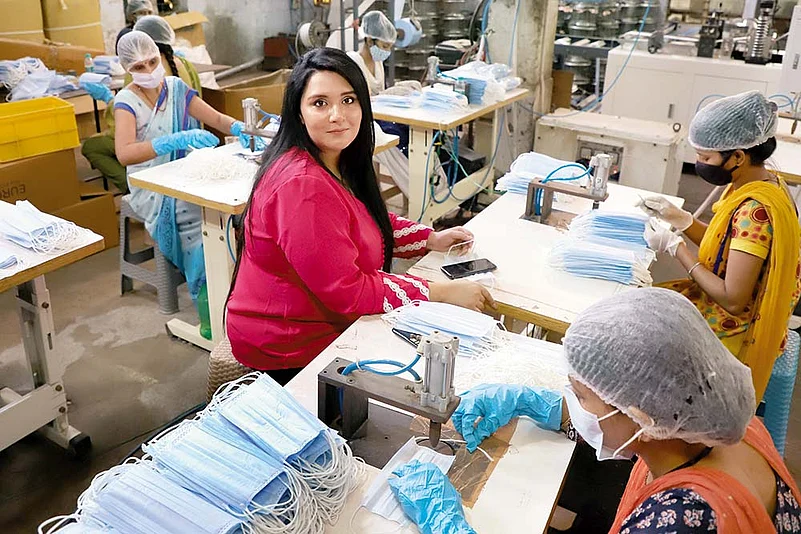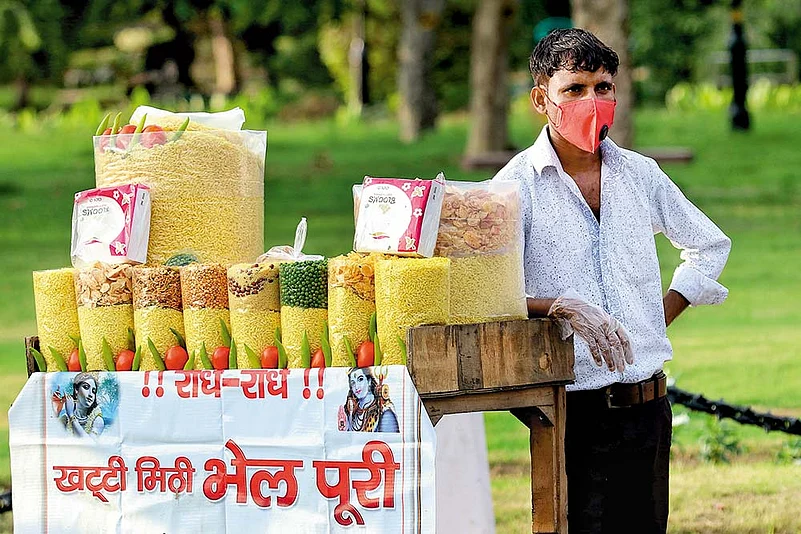Pop! The ideas bottle opens, and the frothy, bubbly, tasty thoughts flow out. A new venture may take shape in the mind of an individual. It may later transform into a start-up or business expansion, or disappear like smoke. However, if it does materialise, entrepreneurship flourishes, jobs are created, and the “Make in India” vision takes a concrete form. A crucial aspect of Aatma Nirbhar Bharat is to fan the business of ideas so that more goods are manufactured in India for the Indian consumers and rest of the world.
The idea can emerge out of nowhere. Call it the entrepreneur’s “eureka” moment. Each year, for years, two friends, Shivjeet Ghatge and Misaal Turakhia, made New Year’s resolutions to get serious about fitness, and regularly go to the gym. Like is the case with most of us, they forgot about them within a few days or weeks. The resolutions vanished as if they were never taken. In 2018, Misaal frustratingly remarked that this wouldn’t happen if only he was paid to go to the gym. That fired a few neurons in their brains’ frontal cortexes. Thus was born the concept of StepSetGo (SSG), an app-based start-up that enables users to get rewards based on their respective fitness regimes. Shivjeet and Misaal roped in a third friend, Abhay Pai, and SSG managed to interest brands such as Bajaj Avenger, Puma and Decathlon. “More than 400 million of us think about fitness, and only 45 million practise it. There is a vast audience to capture,” says Shivjeet.
ALSO READ: Swadeshi Movement Part 2
Charu, a Delhi-based businesswoman who made tools (spanners and screwdrivers) for car-makers, saw her operations being decimated by the COVID-19 pandemic. Unable to pay salaries, and desperate for cash, she began to trade in face masks. She procured them locally, and sold them globally through her business networks. Within months, she purchased two machines to make them at her factory. Today, she sells 10 million every month. Imagine her profits even if she saves a rupee on each mask.
Like most sectors, textiles took a beating in the past few months, due to COVID-19. However, several clothing makers made a killing, as they emerged as large exporters of personal protective equipment (PPE). Between March and August, they sold almost 13 million kits within the country, and exported an additional 14 million to Senegal, Slovenia, UAE, the UK and the US. A public health challenge, and economic paralysis, was turned on its head—into a profitable opportunity.
ALSO READ: Inequality Paradox
This is the mindset that helps to keep the entrepreneurial spirit alive—and kicking. One indicator: on an average, 100 new start-ups are born every day in India; in 2018, there were 50,000 of them. If the current pace—a year-on-year growth of 12-15 per cent—continues, the country may well have a million start-ups in no time. Today, India boasts of the world’s third largest base of new entrepreneurs. Another pointer: India attracted almost $400 billion FDI since April 2014.
However, the idea isn’t enough. The failure rate among new businesses is 90 per cent. Angel investors, venture capitalists and private equity players fund 10 ventures, and fervently pray for one to turn into an Amazon. Well, even a Flipkart is welcome. Thus, what is needed is an ecosystem that can nourish projects. Capital is one of the ingredients. In addition, one requires a stable policy framework, technology, management bandwidth, and loads of ambition and risk-taking abilities.
ALSO READ: Think Indian Dot Com
Consider the example of Shivanshi Verma, a third-year student of IIT Ropar. Along with her studies, she is committed to a start-up, YOBOSHU, a fitness aggregator for users in Ropar and Chandigarh. What sustains her is the seed capital of Rs 15 lakh provided by her institute and the fact that faculty members act as mentors. Thus, capital, technology, infrastructure and management expertise are available in a single location. These bolster her overall confidence.

Neha Chopra at her mask-manufacturing unit in Delhi.
Such an environment for manufacturing is possibly what the Centre hopes to build through the “One-District One-Product” (ODOP) approach. This will add to the overarching Aatma Nirbhar Bharat scheme, and feed into others like “Make in India 1.0 and 2.0”, and #VocalForLocal. In a written reply to Parliament, Mahesh Poddar, the minister for commerce and industry, explained that ODOP was “a transformational step forward realising the true potential of a district, fuel economic growth, and generate employment and rural entrepreneurship”.
ALSO READ: Bharat Inc.
Each district across the country will become a distinct export hub, which will specialise in a single product. The Centre and states will help manufacturers to locate global clients, scale up production and quality, and promote the products. Uttar Pradesh initiated this a few years ago, and partnered with industry association, FICCI, to conduct road shows. The desire is to popularise and sell unique items such as leather footwear, carpets, chikan fabrics, terracotta and brassware.
Not everyone is enthused by it, though. “There is nothing new in it,” says a deputy commissioner in Punjab. “In Punjab, a similar pattern was working for decades—for example, Jalandhar is famous for sports goods, Ludhiana for bicycles and woollen clothing, and Mandi Gobindgarh for secondary steel.” Today, the problem is how to revive these traditional and mature industrial clusters, which are going through near-death experiences due to various reasons.
ALSO READ: ‘I’ Of The Storm
Mandi Gobindgarh is on the decline due to cheap steel imports from China. Manufacturers in Jalandhar are unable to compete with new brands like Decathlon. On top of these, policies like GST negatively impact the MSME sector. “Both the Centre and states have to understand that large and immediate investments, as well as beneficial measures, are required for survival strategies that include product innovation and ability to compete with the bigger brands,” the official adds.
What is more worrisome is that even as New Delhi targets Beijing in different ways, the former desires to follow the Red Dragon’s success route. In fact, ODOP began in China years ago. The modern concept of business clusters was defined three decades ago by management guru, Michael Porter, in his best-seller, The Competitive Advantage of Nations. One forgets that such geographical concentrations work only if the lab-to-market extensions are firmly established.
In China, for example, districts or specific regions include research labs, innovation centres, small and large producers, and exporters, which together cater to the local, national and international markets. In addition, raw material suppliers and other vendors congregate in such areas. This creates a complete and autonomous hub, which is self-sufficient. India’s ODOP can work if the Aatma Nirbhar Bharat concept is established at various levels, and among different sectors.
A holistic vision is important for other reasons, as Indian textile-makers discovered in the past few months. Even as their PPE exports grew impressively, there was a major lacuna. A tiny, but vital, component, the needle, was missing in action. The reason: India imports most of the stitching needles. The main global supplier is Groz-Beckert—one of the oldest German companies, founded in 1852, it makes 70,000 products, apart from needles, and sells in 150 countries.
“Germany produces the best needles, which are superior and long-lasting. One isn’t sure about the Chinese products,” says a senior executive in Orient Craft, a leading Indian clothing manufacturer. This is ironic and dismal. The country’s textiles sector, which contributes 7 per cent to industry output, 2 per cent to annual GDP and 15 per cent to export earnings, and employs 45 million people, depends on imports for the supply of needles. These are areas where the policy-focus needs to be.
One can argue that to enmesh with self-reliance, ODOP has to move beyond handicrafts, agriculture produce and traditional products. Instead, it may be a good idea to improve and enlarge industrial clusters that have cropped up either due to, or despite, the government’s interventions. For the self-reliance crusade to truly take off, India has to emerge as a major global supplier, and a large consumer, of steel, power, mobile handsets and capital goods. We have to be both buyers and sellers.
Similar problems plague start-ups. A technology expert, who works in a global think-tank, feels that most Indian entrepreneurs blindly borrow ideas developed in other countries, or improvise existing tech products. “This is true across genres. The trouble is that they do not focus on long-term goals, but seek short-term gains,” he adds. No one wants to build a global brand. The majority wishes to take the advantage of valuations, and exit as soon as it can profitably sell the companies.
Although the start-up ecology is way better than it was a decade ago, there are several challenges. The money pipeline of the risk-funders is overflowing and, hence, equity is available from venture capitalists and private equity players. But a majority of entrepreneurs are unable to access loans, and other forms of finance. In most surveys, the top complaint of founders is lack of money and access to funding sources. Hence, the fear of failure in India is higher than the Asian and global averages.
It is, therefore, not surprising that most start-ups prosper in spite of the government—like the contested claim made by the software sector. “Our revenue model has a lot to do with advertisements and brand tie-ups. We don’t spend on marketing,” explains SSG’s Shivjeet. He adds that the app doesn’t need help or intervention from the government. This, he contends, is true aatma nirbharta—an example of a “self-dependent and self-sustainable” money-churning business model.
However, the future of entrepreneurship lies in products and product design. “We lack in these areas. But start-ups have to realise that tech and tech-aided solutions cannot make the country self-sufficient,” says L. Nitin Chordia, who quit his cushy corporate job after six years and, in 2013, started a chocolate-making school, Cocoashala. Six years later, he launched the world’s first zero-waste and sustainable (free of paper and plastics) bean-to-bar chocolate, Kocoatrait.
Such innovations and implementation will be the new name of the game. Gone are the days when bare-bone ideas sold, and money flowed on the basis of rough sketches on paper napkins, or wire-frame presentations on laptops. As the new rules kick in, India enjoys several advantages over other nations such as the US and China. As D.K. Aggarwal, president, PHD Chamber of Commerce & Industry, explains, “India offers the 3Ds for businesses—democracy, demography and demand.”
But these windows of opportunities will close in 2-3 decades. By 2050, democracy may no longer be considered to be an entrepreneurial edge. India’s demographics will change for the worse in three decades, as the nation gets crowded with older people. Internal demand will grow so long as the waistline of the socio-economic order bulges out, i.e. until the size of the middle class widens and incorporates the sections below it. This process too will stagnate within 30 years.
***
State Startup Ranking 2019
Best Performers Andaman and Nicobar Islands; Gujarat
Top Performers Karnataka; Kerala
Leaders Maharashtra; Bihar; Odisha; Rajasthan; Chandigarh
Aspiring Leaders Punjab; Telangana; Uttarakhand; Jharkhand; Haryana
Emerging Startup Ecosystems Chhattisgarh; Uttar Pradesh; Tamil Nadu; Sikkim; Nagaland; Mizoram; Madhya Pradesh; Assam
Source: DPIIT, Government of India
















